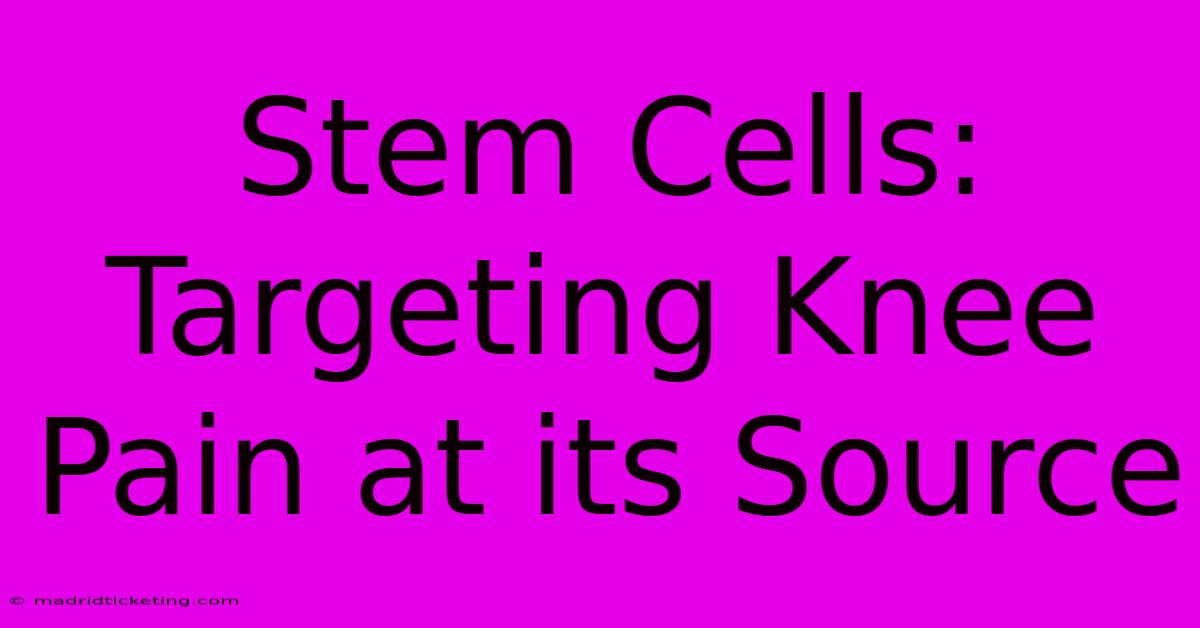Stem Cells: Targeting Knee Pain At Its Source

Table of Contents
Stem Cells: Targeting Knee Pain at its Source
Knee pain. It's a debilitating condition affecting millions, hindering mobility and impacting quality of life. From minor aches to debilitating osteoarthritis, the causes are varied, but the suffering is real. Traditional treatments often offer only temporary relief, leaving many searching for lasting solutions. Enter stem cell therapy, a revolutionary approach targeting the root cause of knee pain. This article explores the potential of stem cells in treating various knee conditions, highlighting the science behind this promising therapy.
Understanding the Source of Knee Pain
Before delving into stem cell therapy, let's briefly examine the common culprits behind knee pain:
1. Osteoarthritis (OA):
This degenerative joint disease is characterized by the breakdown of cartilage, the cushioning tissue between bones. The resulting bone-on-bone friction causes pain, stiffness, and limited movement. OA is a leading cause of knee pain, particularly in older adults.
2. Meniscus Tears:
The meniscus, a C-shaped cartilage pad in the knee, acts as a shock absorber. Tears in the meniscus, often caused by injury, can lead to significant pain, swelling, and instability.
3. Ligament Injuries:
The knee's ligaments provide stability. Injuries to these ligaments, such as ACL (anterior cruciate ligament) tears, can result in severe pain, instability, and potentially long-term disability.
4. Tendinitis:
Inflammation of the tendons surrounding the knee joint, often caused by overuse or injury, can cause significant pain and discomfort.
How Stem Cell Therapy Works for Knee Pain
Stem cells are unique cells capable of self-renewal and differentiation—meaning they can develop into various specialized cell types. In the context of knee pain, stem cell therapy harnesses this potential to:
- Reduce inflammation: Stem cells release anti-inflammatory molecules, helping to alleviate pain and swelling.
- Repair damaged cartilage: Stem cells can differentiate into chondrocytes, the cells that produce cartilage. This helps repair damaged cartilage and restore the joint's cushioning.
- Promote tissue regeneration: Stem cells stimulate the body's natural healing processes, promoting the repair and regeneration of damaged tissues in the knee joint.
- Improve joint function: By addressing the underlying causes of knee pain, stem cell therapy aims to improve joint function, mobility, and overall quality of life.
Types of Stem Cells Used in Knee Pain Treatment
Several types of stem cells are used in knee pain treatment, each with its own advantages and disadvantages:
- Mesenchymal Stem Cells (MSCs): These are commonly sourced from bone marrow, adipose tissue (fat), or umbilical cord blood. MSCs are known for their anti-inflammatory and regenerative properties.
- Autologous Stem Cells: These are derived from the patient's own body, minimizing the risk of rejection and immune response.
- Allogeneic Stem Cells: These are obtained from a donor. While easier to obtain, there’s a higher risk of rejection.
The Procedure: A Look at Stem Cell Injection
Stem cell therapy for knee pain typically involves a minimally invasive procedure. Stem cells are injected directly into the affected knee joint under imaging guidance (usually ultrasound or fluoroscopy). The procedure is generally well-tolerated, with minimal downtime.
Potential Benefits of Stem Cell Therapy for Knee Pain
The potential benefits of stem cell therapy for knee pain are significant:
- Reduced pain and inflammation: Many patients experience significant pain relief and reduced inflammation following stem cell therapy.
- Improved joint function: Stem cell therapy can improve range of motion and mobility.
- Reduced reliance on medication: It may help reduce or eliminate the need for pain medication.
- Improved quality of life: By addressing the underlying causes of knee pain, stem cell therapy can improve overall quality of life and increase physical activity.
Potential Risks and Side Effects
While stem cell therapy is generally considered safe, potential risks and side effects include:
- Infection: As with any injection, there is a small risk of infection at the injection site.
- Bleeding or bruising: Some bleeding or bruising may occur at the injection site.
- Pain or swelling: Temporary pain or swelling is possible.
Important Note: It's crucial to consult with a qualified healthcare professional to determine if stem cell therapy is right for you. Not everyone is a suitable candidate for this treatment. The effectiveness of stem cell therapy can vary, and results are not guaranteed.
The Future of Stem Cell Therapy for Knee Pain
Research into stem cell therapy is ongoing, with promising results emerging. As scientists continue to refine techniques and explore new avenues, stem cell therapy holds immense potential as a transformative treatment for knee pain, offering hope for lasting relief and improved quality of life for millions. The future looks bright for individuals seeking less invasive and more effective ways to manage this debilitating condition.

Thank you for visiting our website wich cover about Stem Cells: Targeting Knee Pain At Its Source. We hope the information provided has been useful to you. Feel free to contact us if you have any questions or need further assistance. See you next time and dont miss to bookmark.
Featured Posts
-
Finding Peace In Remembering Phrases For Loss Of Parents
Apr 06, 2025
-
From French Riviera To Spanish Sun Train From Nice To Madrid
Apr 06, 2025
-
Ronaldos Real Madrid 2017 Jersey A Collectors Item
Apr 06, 2025
-
Affordable Housing Your Chance To Own In Madras
Apr 06, 2025
-
Real Madrids Winning Strategy Virtus Bolognas Response
Apr 06, 2025
